The controversies surrounding The Late Late Show in its first decade seem today bizarre, inexplicable and farcical. They reflect an Ireland struggling to emerge from the post-independence social and economic doldrums, where the Catholic Church ruled and there appeared to be a national obsession with sex.
This was perhaps best summed up by the colourful Fine Gael politician Oliver J Flanagan who, with a serious face, told Gay Byrne there was no sex in Ireland until television came along.
By 1966, when the most infamous controversy of the show’s long run, relating to what became known as “the Bishop and the Nightie”, became a national talking point, the show had ceased to be the light summer filler planned when it was launched in 1962.
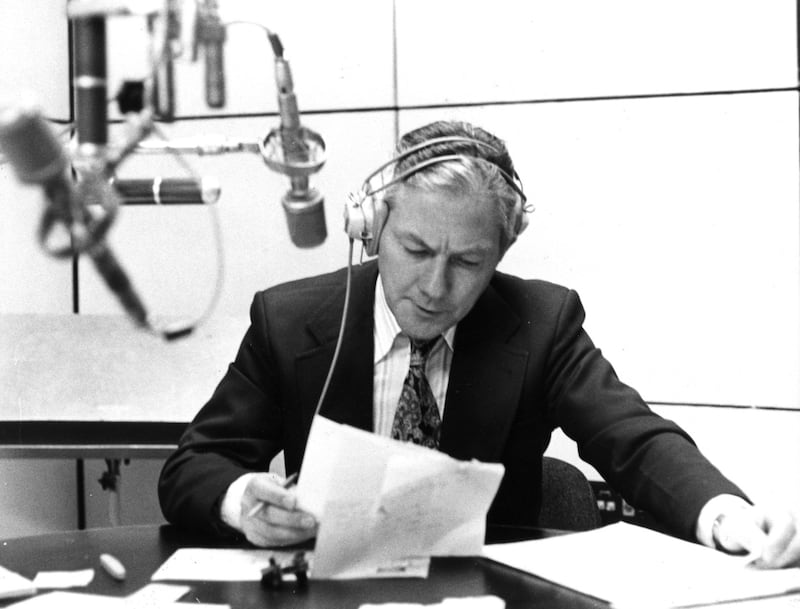
Byrne was by now both presenter and producer and the show was dealing with contentious social issues, while retaining a strong light-entertainment content.
What eventually led to the Bishop and the Nightie controversy was very much intended to be light entertainment.
Lighthearted filler
In what he thought would be a lighthearted filler, modelled on a US television show, Byrne interviewed married couples separately about their personal lives. If their answers tallied, they won a prize.
One of the questions related to the colour of the nightie worn by the wives on their honeymoon night.
One woman could not remember and remarked she might have worn none.
The response, Byrne later recalled, was “rollicking and understandable’’ laughter. The show moved on to the next item.
But one viewer, in particular, was not amused. The then Bishop of Clonfert, Dr Thomas Ryan, watching the programme at home in Loughrea with some parishioners, was appalled.
Regarded as an amiable man, he was appointed to the hierarchy after a career as a Vatican diplomat. Those who knew him at the time said later he found the transition to the relative isolation of a rural bishopric difficult.
That Saturday night he was having some drinks and, he would later privately admit, his judgment was not the best.
He issued a statement to the now defunct Sunday Press newspaper expressing disgust at the item.
“This protest has to be made in fairness to Christian morality,’’ he declared.
“I am greatly disappointed in whoever was responsible for drafting the questions, disappointed in the man who read them, and even more disappointed in the people who answered them.’’
The bishop repeated his criticism when he preached at Mass in the cathedral on the following morning.
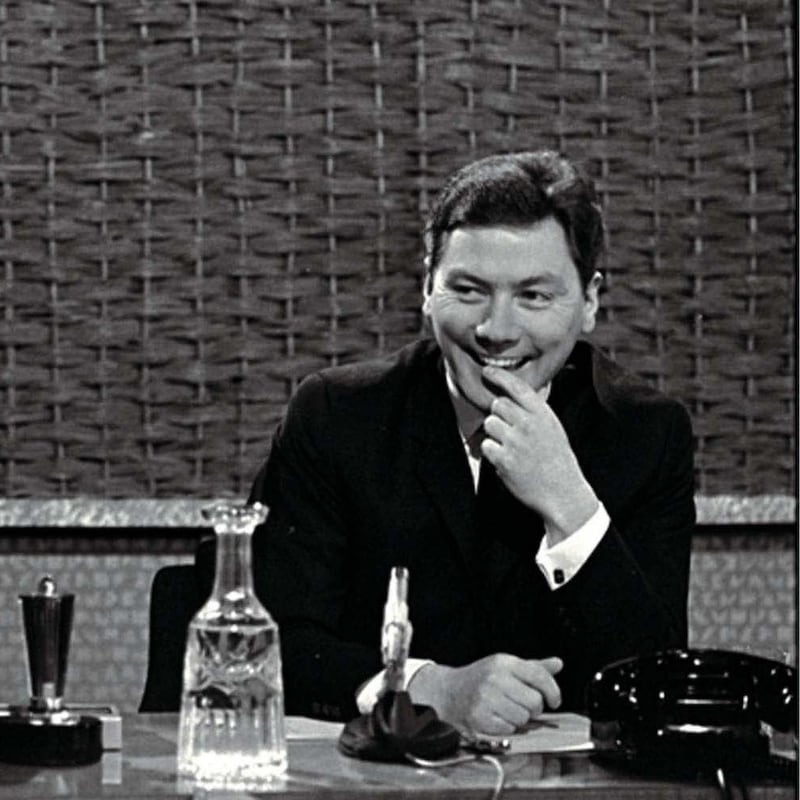
Finola Doyle O’Neill, in her book, The Gaybo Revolution, How Gay Byrne Challenged Irish Society, revealed the then Archbishop of Dublin, Dr John Charles McQuaid, added his weight to the criticism when he wrote privately to the then RTÉ director general Kevin McCourt.
McQuaid observed the questions and answers in the case of the married couple were “vulgar, even coarse and suggestive’’.
The Loughrea Town Commissioners was among local councils throughout the country to voice criticism, with one member describing the show as “a dirty programme that should be abolished altogether’’.
Not everybody took the controversy seriously, with one letter-writer to The Irish Times, Oscar Love, of Blackrock, finding it hilarious
The Irish Catholic newspaper referred to the national broadcaster’s growing tendency “to play down the grave implications of the sixth and ninth commandments’’.
An editorial in The Irish Times attempted to put the controversy in perspective.
“While feeling that His Lordship was killing a fly with a sledge hammer . . . the bishop in this case may find that, as our music hall correspondent tells us, Saturday night’s joke is one of the staples of vaudeville and may have bored more viewers than it offended,’’ it said.
“A lapse of taste has been treated as if it were an outrage to morals.’’
Not everybody took the controversy seriously, with one letter-writer to The Irish Times, Oscar Love, of Blackrock, finding it hilarious.“It should be recognised that night attire is not in use throughout the world,’’ he wrote. “Many of my male friends go to bed in the raw and, in west Cork, they wear corduroys.’’
RTÉ apologised, much to Byrne’s annoyance. The bishop later, through intermediaries, apologised to Byrne and the couple.
The Bishop and the Nightie has been quoted over the years by commentators as an example of how daft an insular society can be.
McQuaid kept a vigilant episcopal eye on issues he considered a threat to faith and morals, particularly when it came to the national broadcaster.
‘Bunny girl’
He was very annoyed when, initially, there were reports the show intended featuring a “bunny girl’’ from the Playboy club in London.
Then, a planned appearance by Playboy’s London representative was cancelled amid controversy, as McQuaid dispatched a letter to McCourt regarding the “bunny man’’.
The show attracted further clerical displeasure when a Trinity College student, Brian Trevaskis, described Galway cathedral as a “ghastly monstrosity’’ and the then Bishop of Galway, Dr Michael Browne, as a “moron’’. He further criticised the Christian Brothers and those clergy responsible for the sacking of banned novelist John McGahern from his teaching post. As the controversy raged, McCourt apologised to Browne for “unkind references’’.
Another student, John Feeney, later to become a prominent journalist, was well known in the 1960s for protesting against the Catholic Church, including outside the gates of Clonliffe seminary.
He caused consternation on the show when he said he knew positively that McQuaid had shares in the condom company, Durex. An angry Byrne, who usually kept his cool, said Feeney’s allegation was more than he could take.
A priest on the panel defended Feeney’s right to express his views and the show ended in chaos. McQuaid wrote to Byrne thanking him for defending his honour.
Cabinet banned
Other contentious issues the show dealt included the compulsory school classes in the Irish language and the then ban on Catholics attending Trinity College, but the reaction to the latter was muted as a consensus about the ban’s absurdity emerged.
As the show developed, Byrne attempted to move it into the political area and invited ministers in the then Fianna Fáil government as guests.
Although some were interested, the then taoiseach Jack Lynch banned his Cabinet from participating in what was at that time RTÉ television’s most controversial forum.
The show featured an all-Traveller evening which, to the surprise of the then Traveller settlement committee, was confined to Travellers only
Divorce, very much a taboo subject at the time, was featured, with Fr Fergal O’Connor, a regular panellist, speaking in favour of its introduction.
He said there was no valid reason why the Catholic Church should object.
Although many Catholic clergy looked on the show with suspicion, some were happy to participate.
They included Fr Eamonn Casey, later Bishop of Kerry, and the “singing priest’’ Fr Michael Cleary, both of whom, it would be revealed many years later, had fathered children.
Fr Cleary used the show as a platform to defend the value of priestly celibacy.
The show, meanwhile, broadened into other areas. It featured an all-Traveller evening which, to the surprise of the then Traveller settlement committee, was confined to Travellers only.
Tribute shows were introduced, where the life and times of a prominent personality were celebrated. In the early years, these included the well-known theatre figure Michael Mac Liammóir, who was involved at the time in an openly gay relationship with colleague Hilton Edwards. But controversy was never far away, even as Ireland mellowed somewhat in the early 1970s.
Using the F-word
The disabled writer, Christy Browne, used the F-word, although it provoked only two complaints.
In March 1971, before the abolition of the marriage bar in the civil service and the introduction of equal pay, the show featured representatives of the newly-formed Irish Women’s Liberation Movement.
It provoked a strong response, negative and positive, and greatly increased the movement’s membership.
At one stage, Byrne handed over the presentation of the show to Marian Finucane, later to become a prominent broadcaster, and the discussion continued on feminism.
The “contraceptive train’’, when a group of women brought bags of contraceptives from Belfast to Dublin by train, as a protest against Ireland’s strict anti-contraceptive laws, was featured on the programme.
McQuaid issued a pastoral letter to warn that the availability of condoms would be a “curse’’ on the country. Some viewers were disgusted that contraception had been discussed on national television. “It would appear that Gay Byrne does not show much concern for future parents and leaders of our country,’’ wrote an angry viewer.
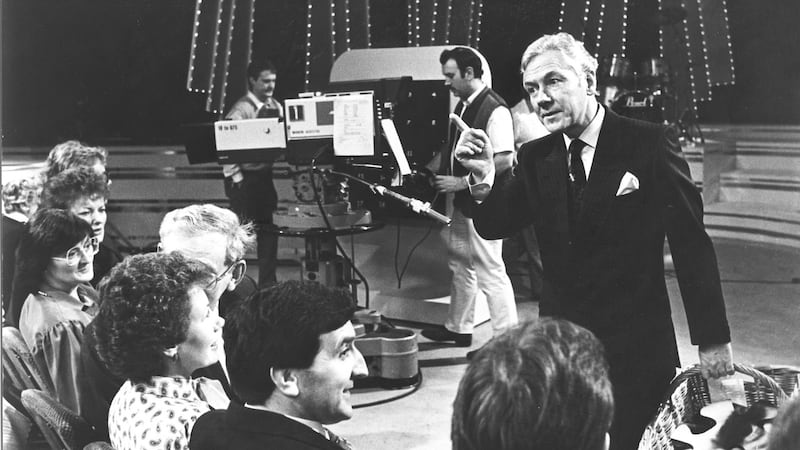
On a different note, the show launched many a showbusiness career, giving exposure to young acts. These included Bob Geldof and this then band, the Boomtown Rats.
Geldof criticised his Catholic upbringing in Dublin, Blackrock College where he went to school, and declared his ambition to “get rich, get laid and get famous’’.
After its first decade, the show had established itself as very much part of Irish society and, for many, an unmissable part of a Saturday night.
It had its detractors, but many were cheering it on as Irish society was slowly but perceptibly changing. The priest, playwright and television programme maker Fr Desmond Forristal observed at the time that the show “had probably done more than any other single factor to form the national consciousness on a hundred different topics’’.
Although a repeat of the bizarre Bishop and the Nightie controversy was unlikely in the 1980s, the show continued to cause controversy. Finola Doyle O’Neill wrote of how it remained under the scrutiny of the RTÉ Authority throughout that decade, with Byrne constantly under the microscope.
‘Madam Sin’
Cynthia Payne, known as “Madam Sin’’, who had served a prison sentence for her role as a brothel keeper, and admitted to having two abortions, was a guest in the early part of the decade.
On the same show, Anna Raeburn, a writer with the women’s magazine Cosmopolitan, said she had an abortion and advocated a woman’s right to choose. RTÉ received about 500 letters of complaint.
An RTÉ directive banned the show from featuring a debate on the controversial 1983 abortion referendum enshrining the equal right to life of the mother and unborn in the Constitution. RTÉ management decided abortion was not an issue to be discussed on “any of the popular talk programmes in the light entertainment department’’.
As Ireland's contraceptive laws became more liberal, Byrne held up a condom on air, describing it as the 'dreaded object'
It was far from the only controversial issue. When it was revealed in the RTÉ Guide that the show intended featuring two lesbian nuns, there was, as Byrne later recalled, “a deluge’’ of obscene letters, telegrams and telephone calls.
“On the night in question there were people down at the RTÉ gate with placards, and there were people praying around the building and showering us with holy water,’’ he wrote in his autobiography. That show got the highest Tam ratings in the station’s history.
Byrne recalled that people were wondering, at the end of the item, what all the fuss was about.
The spread of Aids was another issue that featured in the programme, with the maturity of the response from viewers giving Byrne “hope’’.
One night in 1987, he did what a few years earlier would have been unthinkable.
As Ireland’s contraceptive laws became more liberal, Byrne held up a condom on air, describing it as the “dreaded object’’. Most people found it amusing and began to wonder what all the fuss about the availability of condoms had been about.
In the mid-1980s, Byrne was offered television work in the United States, starting with a local show and, if successful, going network.
Although he went to the United States to do some pilot programmes, and filled in as a presenter for shows over a few summers, he eventually opted to stay in Ireland.
Byrne wrote in his 1989 autobiography that he would probably finish up as presenter of the show in 1992, by which time it would be 30 years on air.
In fact, Byrne continued to present the show until 1999, presiding over a further share of controversy in that final decade.
Adams handshake
When the then Sinn Féin leader Gerry Adams was a guest on the show in 1994, Byrne was instructed by RTÉ management not to shake his hand. Some years later, he would interview Adams on television again, as the peace process had bedded down, and they would make a very public handshake.
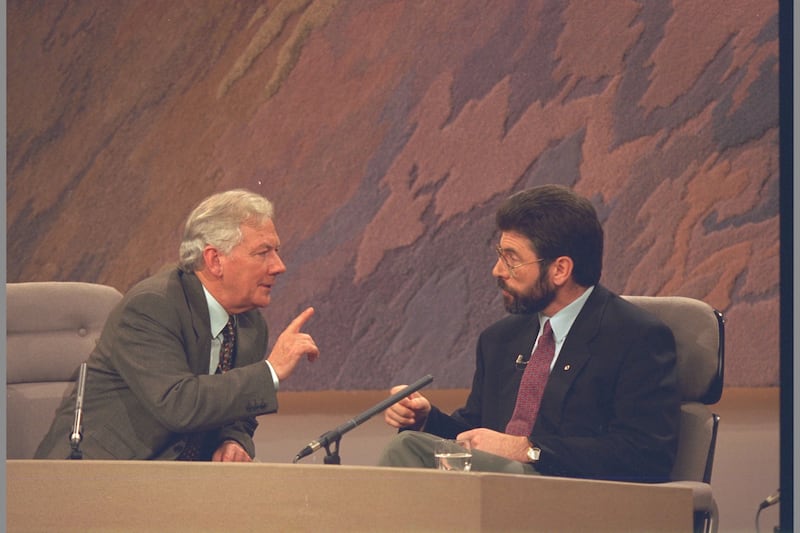
Members of Boyzone were guests in the early part of their career and engaged in a shambolic dancing routine. But, like countless performers who had appeared on the show over the years, they went on to greater things.
Byrne’s interview with American-born Annie Murphy, who had a son with Bishop Eamonn Casey when they had an affair in the 1970s, caused huge controversy.
Byrne’s tone was considered hostile and he suggested to Murphy that if her son, whom she had reared, was half as good a man as his father, he would not be doing too badly.
“I’m not so bad either, Mr Byrne,’’ replied a visibly angry Murphy.
Journalist Ann Marie Hourihane, who had worked on Byrne’s radio programme, later described the Murphy interview as “a misogynistic disaster’’ in an article in The Irish Times.
Some close to Byrne put down his professional lapse to his friendship with Casey, which went back to the 1960s.
The final year of the show, 1999, featured two particularly controversial interviews which attracted huge public interest.
The then EU commissioner Pádraig Flynn spoke of the financial strain in running three houses, in Mayo, Dublin and Brussels, despite his enormous salary.
Asked about allegations he had taken a €50,000 bribe from Sligo-born developer Tom Gilmartin, Flynn replied that neither Gilmartin nor his wife were “well’’.
Gilmartin, who was watching the show, transmitted by satellite, in Luton, England, took the remark personally and decided to testify at the Mahon tribunal investigating corruption in the planning process.
The tribunal later found Flynn had “wrongly and corruptly’’ sought a £50,000 payment from Gilmartin in 1994, which he used to buy a farm in Co Mayo in his wife Dorothy’s name.
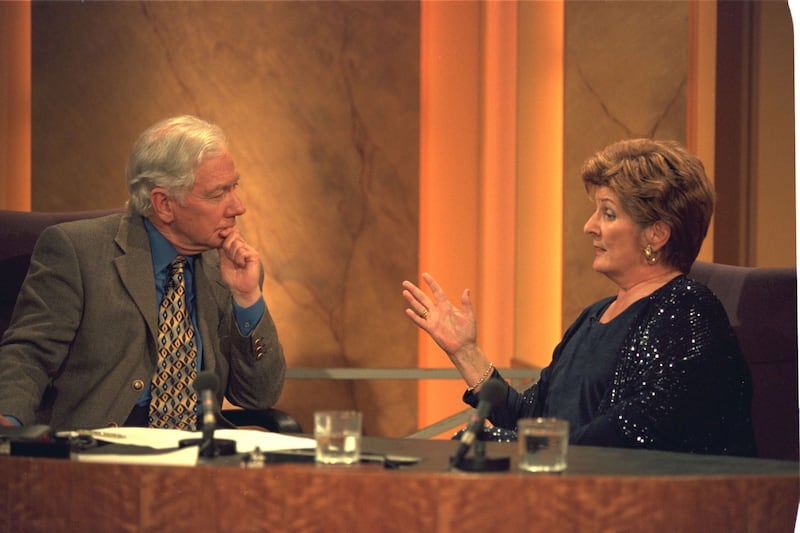
Haughey
Although journalist Terry Keane’s long relationship with former taoiseach Charles Haughey was well known in media circles, and among the Dublin chattering classes, her interview with Byrne was considered sensational and a major broadcasting coup when she decided to go public on the penultimate show.
Keane spoke of how she had been Haughey’s mistress for 27 years, how his wife must have known in the same way her husband knew. “I think he loved me very much,’’ she added. “I love him very much.’’
Keane later said she regretted doing the interview.
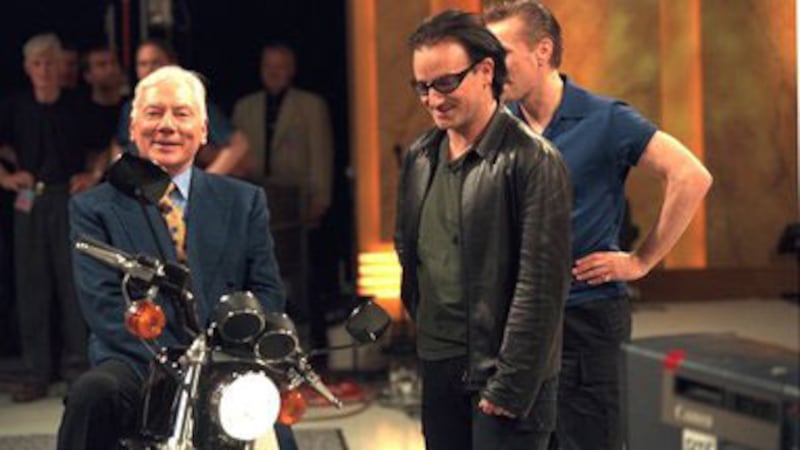
In his final show, the then president Mary McAleese was among those who dropped in to wish him well, while Bono and Larry Mullen of U2 presented him with a Harley Davidson motorbike.
He signed off, remarking the decades of involvement with the show had been a marvellous roller-coaster.
The light summer television filler of 1962 had lasted for 37 years, with Byrne continuously at the helm, except for Frank Hall during a brief period in the 1960s.
As the tributes flowed, nobody doubted that, notwithstanding the contribution of many others, Byrne’s broadcasting genius was responsible for its long run.













